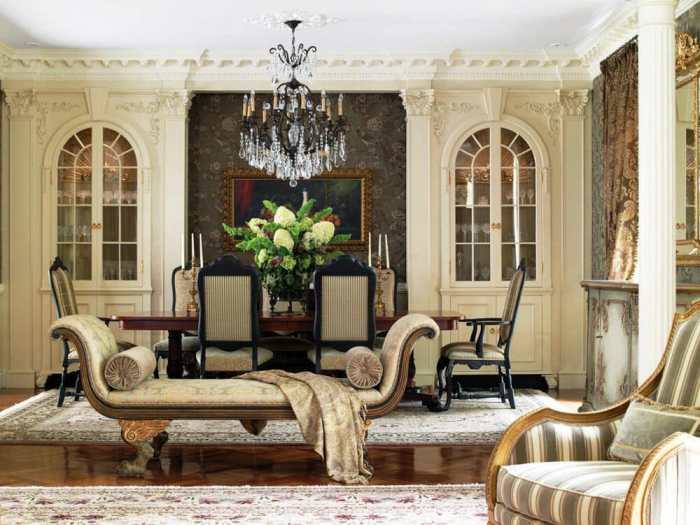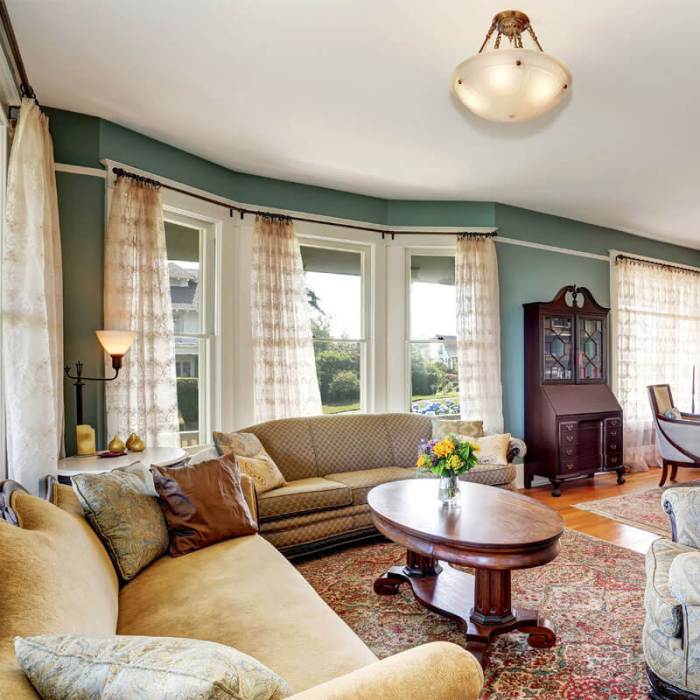Exploring Traditional Interior Design: Key Elements and Color Schemes
Traditional interior design captures the essence of timeless elegance and sophistication, blending rich textures, warm colors, and intricate patterns to create inviting spaces that exude charm and comfort. As we delve into the world of traditional interiors, we uncover the secrets behind its enduring popularity and the unique elements that define this classic style.
Traditional Interior Design Elements
Traditional interior design is characterized by a classic and timeless look that exudes warmth and elegance. Key elements of traditional design include the use of warm colors, rich textiles, and intricate patterns that create a cozy and inviting atmosphere. Wood furniture and antiques also play a significant role in traditional design, adding a sense of history and sophistication to the space.
Warm Colors, Rich Textiles, and Intricate Patterns
In traditional interior design, warm colors like deep reds, golden yellows, rich greens, and earthy browns are commonly used to create a sense of comfort and luxury. These colors are often complemented by rich textiles such as velvet, silk, and brocade, which add texture and depth to the space.
Intricate patterns like floral, damask, and paisley are also prevalent in traditional design, adding a touch of elegance and sophistication to the decor.
Wood Furniture and Antiques
Wood furniture is a staple in traditional interior design, with pieces crafted from rich woods like mahogany, cherry, and oak. These furniture pieces often feature intricate carvings, turned legs, and ornate details that contribute to the overall classic look of the space.
Antiques, whether inherited or collected over time, are also prized in traditional design for their sense of history and character they bring to the room.
Color Schemes in Traditional Interior Design

Color plays a crucial role in traditional interior design, setting the tone and mood of a space. Traditional interiors often feature rich, timeless color schemes that create a sense of warmth and elegance.
Deep, Earthy Tones vs. Pastel Shades
When it comes to traditional interior design, deep, earthy tones and pastel shades are two popular color schemes that are commonly used. Let's explore the characteristics of each and how they contribute to the overall traditional aesthetic:
- Deep, Earthy Tones:
Deep, earthy tones like burgundy, forest green, navy blue, and rich browns are often used in traditional interiors to create a sense of sophistication and coziness. These colors evoke a sense of tradition and history, adding depth and warmth to the space.
When paired with traditional furniture pieces and classic patterns, deep, earthy tones can create a timeless and elegant look.
- Pastel Shades:
On the other hand, pastel shades like soft blues, muted pinks, and light yellows can also be used in traditional interiors to add a touch of softness and femininity. Pastel shades create a light and airy feel, perfect for creating a sense of calm and tranquility in a space.
When combined with traditional design elements like ornate moldings and antique furniture, pastel shades can bring a sense of charm and grace to the room.
Furniture and Decor
In traditional interior design, furniture and decor play a crucial role in creating a timeless and elegant space. The pieces chosen are often classic and sophisticated, reflecting a sense of history and tradition.
Types of Furniture in Traditional Interior Design
- Antique furniture: Pieces with intricate details and craftsmanship, often passed down through generations or sourced from specialty stores.
- Wood furniture: Rich, dark woods like mahogany, cherry, or walnut are commonly used for tables, chairs, and cabinets.
- Upholstered furniture: Sofas and chairs with ornate fabrics like velvet, silk, or damask, featuring tufting and fringe details.
- Coffee tables and side tables: Often made of wood with intricate carvings or inlay work, adding a touch of elegance to the room.
Symmetry and Balance in Furniture Placement
Symmetry and balance are key principles in traditional interior design when it comes to arranging furniture. This creates a sense of harmony and order in the space, enhancing the overall aesthetic appeal.
Enhancing Traditional Spaces with Accessories
- Curtains: Heavy drapes in luxurious fabrics like silk or velvet, often in rich colors or intricate patterns, add warmth and sophistication to the room.
- Rugs: Oriental rugs with intricate designs or Persian carpets can anchor the space and add texture and color to the floor.
- Artwork: Oil paintings, tapestries, or framed prints depicting classical scenes or landscapes can add a touch of culture and history to the walls.
Architectural Details

In traditional interior design, architectural details play a crucial role in enhancing the overall aesthetic of a space. These elements add character, sophistication, and charm to traditional interiors, creating a timeless and elegant look.
Crown Molding
Crown molding is a classic architectural detail that is commonly found in traditional interiors. It is a decorative trim installed where the walls and ceiling meet, adding a touch of elegance and visual interest to the space. Crown molding can vary in size, shape, and intricacy, allowing for customization to suit different design styles.
Wainscoting
Wainscoting is another architectural detail often seen in traditional interior design. It involves installing decorative panels on the lower half of the walls, typically made of wood, to add texture and visual appeal. Wainscoting not only enhances the aesthetic of a space but also serves a practical purpose by protecting the walls from damage.
Coffered Ceilings
Coffered ceilings are a striking architectural feature that can elevate the traditional aesthetic of a room. These ceilings consist of recessed panels or beams arranged in a grid pattern, creating a sense of depth and architectural interest. Coffered ceilings add a sense of grandeur and sophistication to a space, making it feel more luxurious and inviting.
Last Recap
In conclusion, traditional interior design offers a harmonious blend of history and refinement, creating spaces that stand the test of time while maintaining a sense of warmth and character. By incorporating traditional elements such as warm color palettes, classic furniture, and architectural details, one can transform any space into a welcoming sanctuary that truly feels like home.
Essential FAQs
What are the key characteristics of traditional interior design?
Traditional interior design is characterized by warm colors, rich textiles, intricate patterns, and the use of wood furniture and antiques to create a timeless look.
How do color schemes contribute to traditional interior design?
Color schemes in traditional interior design play a crucial role in setting the tone and ambiance of a space, with deep, earthy tones and pastel shades often used to create a cozy and inviting feel.
What types of furniture are commonly found in traditional interior design?
Traditional interior design features classic furniture pieces such as wingback chairs, Chesterfield sofas, and ornate wooden tables that emphasize symmetry and balance in a room.
What architectural details are characteristic of traditional interior design?
Architectural elements like crown molding, wainscoting, and coffered ceilings are often used in traditional spaces to add depth and elegance, elevating the overall aesthetic.